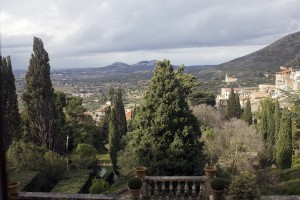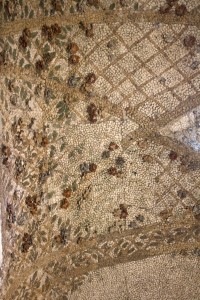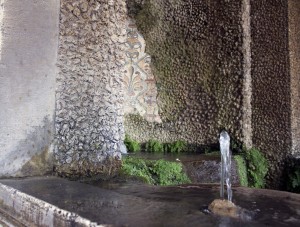
Connected to Rome by the famous Via Tiburtina, the town of Tivoli dates back to antiquity and is famous not only for its beautiful ruins and classical architecture, but also for its place as a producer of extremely fine olive oil. Indeed, our first glimpse of Tivoli was from between the branches of the ancient olive trees that line the roads and lead up to sweeping hillside orchards. During our day trip, we visited two important villas in this charming area. Our first stop was Villa Adriana—or in English—Hadrian’s Villa.
Hadrian began restructuring an existing estate on the land that soon became one of the largest imperial villas. Gaining a reputation as the most philhellenic of Rome’s emperors, he traveled greatly through the Mediterranean, introducing many Greek statues to Rome over his 20-year reign. Reflecting his love of Greece and Egypt, Hadrian named many parts of his villa after places he visited and commissioned many sculptures and other artworks inspired by Greek designs. Hadrian’s Villa differs from many other villas built at the time in that it was not only intended as a place of leisure but also as an important administrative center. While the ruins surrounding the villa date as far back as the second century, most of the vegetation present at this site was restored and dates to the 18th and 19th centuries.
Moving from Hadrian Villa’s to the Villa d’Este emphasized the influence antique architecture had on later approaches to space, garden design, and imagery. In fact, this deep love of ancient art forms and styles of construction is especially evident throughout the elaborate wall paintings and grotto facades at Villa d’Este. The sense of wandering through an ancient cave is evoked through the use the pumice stone on the ceilings and walls of many of the passageways on the lowest level. This is contrasted with more typical renaissance paintings upstairs as well as trompe l’oeil marble details, strong Greek and Egyptian influences, and biblical illustrations.

A common thread throughout our afternoon at both Hadrian’s Villa and Villa d’Este was the role of water. Whether in fountains, formal ponds, or bathhouses, the sense of light, color, and movement inspired by these water features was a powerful design element and allowed us to imagine the courtyards and gardens of these once powerful estates rich with life and activity. Another facet of both sites was the alternation between open and closed spaces and thus the rhythm of movement through the residences, dining rooms, and courtyards. An important note particularly pertinent to Hadrian’s Villa was the lack of decoration present. Originally ornately detailed with colorful floors, walls, sculptures and marble facades, today Hadrian’s Villa stands stripped and pillaged of its former symbols of grandeur. Indeed the only remaining evidence of the facades is the series of holes piercing the brick walls and indicating the layout of the once attached marble coatings.

Despite the overcast January weather, our visit to these two remarkable sites in Tivoli was illuminating, thought provoking, and inspiring.
